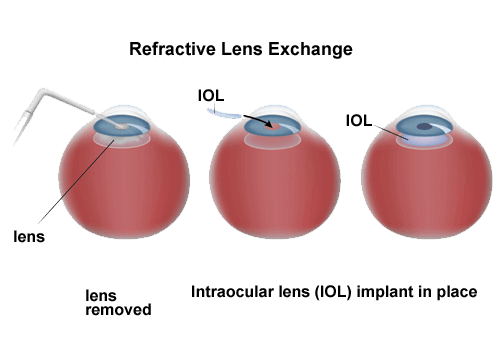Posted by: Focal Point Vision in Blog

Laser vision correction procedures are among the most popular elective procedures in the United States. Each year, millions of people undergo these procedures to improve their vision so they don’t need to rely on glasses or contacts.
If you have age-related vision changes or presbyopia, refractive lens exchange may be the best vision correction procedure for you. It can correct your refractive errors, bring you visual freedom from glasses and contacts, and prevent further age-related vision changes from cataracts.
Keep reading to learn more about 7 signs you may be a good candidate for refractive lens exchange.

What is Refractive Lens Exchange?
Refractive lens exchange, or RLE, is a type of vision correction procedure that improves your vision by replacing the natural lens of the eye with an intraocular lens (IOL). It is often used for patients with presbyopia to reduce their reliance on visual aids.
The procedure is almost identical to cataract surgery. However, most patients who undergo refractive lens exchange have not developed cataracts or have early cataracts and want to address them before they cause vision problems.
Who is a Good Candidate for Refractive Lens Exchange?
The best candidates for refractive lens exchange are people over 40 experiencing age-related vision changes and want visual freedom from glasses and contacts. Here are 7 more signs you may be a good candidate for refractive lens exchange:
1. Your Prescription Is Too Severe for LASIK
LASIK is a popular option for laser vision correction, but it’s only effective for a specific range of prescriptions. Refractive lens exchange is a good option for people with more than -6.00 diopters of nearsightedness or more than +3.00 diopters of farsightedness.

2. You Have Presbyopia
Presbyopia, or age-related farsightedness, is a common vision condition developed by people over 40. It occurs when the lens of the eye becomes less flexible, and you begin to have difficulty focusing on close-up objects.
You may find that you need reading glasses to read or go on your phone. Refractive lens exchange can correct this refractive error by removing the natural lens and replacing it with an IOL.
3. You Want Vision Correction at Multiple Distances
IOLs offer different types of vision correction, allowing you to correct your vision at one distance or multiple distances. You can achieve excellent visual freedom by choosing a premium IOL like the J&J Symfony IOL offered at Focal Point Vision.
It provides the greatest versatility in your vision, allowing you to see things in vivid clarity up close and at a distance.
4. You Have Significant Astigmatism
When you undergo refractive lens exchange, you can choose a toric IOL to correct astigmatism. They can correct astigmatism up to 3.50 diopters and come in different varieties.
5. You’re Interested in Cataract Correction or Prevention
Cataracts develop on the natural lens of the eye, causing cloudy spots that affect your vision. Most cataracts are age-related and begin to develop after the age of 40.
The only way to treat cataracts is with cataract surgery. However, because refractive lens exchange removes the natural lens and replaces it with an IOL, it can remove and prevent cataracts in the same way that cataract surgery can.
6. You Want Permanent Vision Correction
Refractive lens exchange offers permanent vision correction. The visual benefits of the procedure will last for the rest of your life, giving you greater visual freedom from glasses and contacts.
7. You’re Ready for Quick Results
Refractive lens exchange offers quick vision improvements. Your vision will likely be noticeably better within the first few days after the procedure and continue improving afterward.
What Can I Expect During My Refractive Lens Exchange Procedure?
Refractive lens exchange is an outpatient procedure, meaning that you get to go home after it is over. Before the procedure, your surgeon will administer eye drops to numb the surface of your eye so you’ll feel comfortable.
Then, they will make a small incision on the surface of your eye so they can access the lens capsule that holds the natural lens. Your surgeon will carefully remove the natural lens, replacing it with the IOL of your choosing.
The entire procedure is typically finished in about 10 to 20 minutes.
What is Recovery Like after Refractive Lens Exchange?
After your procedure, you will need someone to drive you home. At your follow-up appointment the day after, your eye doctor will give you specific instructions about when you can resume activities like driving and going to work.
You will need to wear an eye shield for the rest of the day and for several nights while you sleep. This prevents you from rubbing your eyes in your sleep.
You will also need to use prescription eye drops to prevent infection and reduce inflammation. You should avoid exercise, swimming, and strenuous activities for several weeks after the procedure.
What Will My Vision Be Like After Refractive Lens Exchange?

Most patients who undergo refractive lens exchange notice their vision improving in less than a week. You will likely experience continued improvements in your vision as your eyes heal from the procedure.
Vision after refractive lens exchange typically reaches peak clarity within about eight weeks. Once you have recovered, you can enjoy crisper, clearer vision without relying on glasses and contacts, depending on the IOL that you choose.
Imagine all the things that will be even better in high definition, like playing your favorite sport, spending time with loved ones, or reading a good book. With refractive lens exchange and a premium IOL, you won’t have to worry about being held back by visual aids, and you can finally live fully in the moment.
Do you want to learn more about whether you are a good candidate for refractive lens exchange? Schedule an appointment at Focal Point Vision in San Antonio, TX, today!
